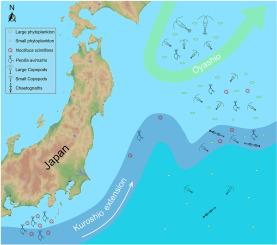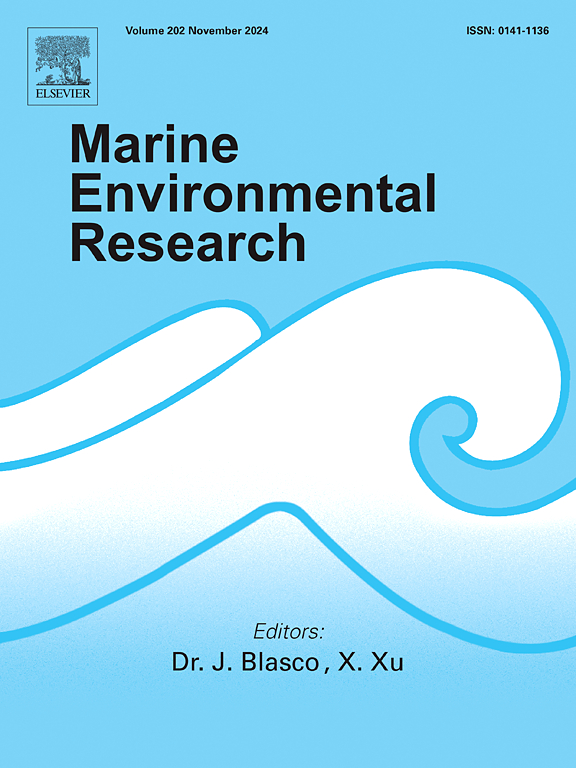黑潮伸展驱动的春季浮游动物群落结构和功能变异。
IF 3.2
3区 环境科学与生态学
Q2 ENVIRONMENTAL SCIENCES
引用次数: 0
摘要
黑潮延伸区及其邻近海域是全球海洋水文变化最剧烈的地区之一。然而,对该地区浮游动物群落结构和功能的研究仍然有限。本文研究了KE对日本东部开放水域浮游动物群落结构和功能的影响。结果表明,KE的存在严重阻碍了南北两岸的水交换,导致浮游动物群落结构存在显著差异。该地区浮游动物丰度高(3791.9 ind.·m-3),物种丰富度低(118个类群),北太平洋副热带环流(NPSG)区浮游动物丰富度高(207个类群),但丰度较低(134.5±112.0 ind.·m-3)。浮游动物种类最多的地区是黑潮-漂潮混水区(KOMW),共有327个类群。从浮游动物的功能类群来看,小体埋伏捕食、杂食-草食和中等体流动捕食、杂食-草食、播撒产卵类在亲潮区和KOMW区占主导地位,而低营养NPSG区以巡航捕食、杂食-草食、囊产卵类占主导地位。此外,平流还将夜luca scintillans和Penilia avirostris等沿海物种输送到日本东部的开阔水域,显著改变了当地浮游动物群落的结构和功能。在KE和KOMW地区的浮游动物群落中,虫蛉虫成为优势种,以虫蛉虫为主的功能群在当地浮游动物群落中表现出较高的相对丰度。本研究增强了我们对东日本海域开放水域浮游动物影响的认识,为深入了解东日本海域及其邻近海域的海洋食物网动态和生物地球化学循环过程提供了科学依据。本文章由计算机程序翻译,如有差异,请以英文原文为准。

Kuroshio extension-driven variability in spring zooplankton community structure and function
The Kuroshio Extension (KE) and its adjacent waters are among the regions with the most drastic hydrological changes in global ocean. However, research on the structure and function of zooplankton communities in this region remains limited. This study focused on the impact of the KE on the structure and function of zooplankton communities in the open waters off eastern Japan. The results showed that the presence of the KE strongly hindered water exchange between its northern and southern sides, leading to significant differences in zooplankton community structure. Zooplankton in the Oyashio regions exhibited high abundance (3791.9 ind.·m−3) and low species richness (118 taxa), while the North Pacific Subtropical Gyre (NPSG) regions had higher species richness (207 taxa) but lower abundance (134.5 ± 112.0 ind.·m−3) compared to the Oyashio regions. The maximum species number of zooplankton occurred in the Kuroshio-Oyashio mixing water (KOMW) regions (327 taxa). Regarding zooplankton functional groups, small-bodied ambush–feeding, omnivore–herbivores and medium-bodied current–feeding, omnivore–herbivores, broadcast spawners were dominant in the Oyashio regions and the KOMW regions, whereas cruise–feeding, omnivore–herbivores, sac spawners prevailed in the oligotrophic NPSG regions. Additionally, the advection of the KE transported coastal species such as Noctiluca scintillans and Penilia avirostris to the open waters off eastern Japan, significantly altering the local zooplankton community structure and function. P. avirostris became the dominant species in the local zooplankton community of the KE and KOMW regions, and functional group primarily consisting of P. avirostris showed high relative abundance in the local zooplankton community. This study enhanced our understanding of the impact of the KE on zooplankton in the open waters off eastern Japan and provided a scientific basis for in-depth comprehension of marine food web dynamics and biogeochemical cycling processes in the KE and its adjacent waters.
求助全文
通过发布文献求助,成功后即可免费获取论文全文。
去求助
来源期刊

Marine environmental research
环境科学-毒理学
CiteScore
5.90
自引率
3.00%
发文量
217
审稿时长
46 days
期刊介绍:
Marine Environmental Research publishes original research papers on chemical, physical, and biological interactions in the oceans and coastal waters. The journal serves as a forum for new information on biology, chemistry, and toxicology and syntheses that advance understanding of marine environmental processes.
Submission of multidisciplinary studies is encouraged. Studies that utilize experimental approaches to clarify the roles of anthropogenic and natural causes of changes in marine ecosystems are especially welcome, as are those studies that represent new developments of a theoretical or conceptual aspect of marine science. All papers published in this journal are reviewed by qualified peers prior to acceptance and publication. Examples of topics considered to be appropriate for the journal include, but are not limited to, the following:
– The extent, persistence, and consequences of change and the recovery from such change in natural marine systems
– The biochemical, physiological, and ecological consequences of contaminants to marine organisms and ecosystems
– The biogeochemistry of naturally occurring and anthropogenic substances
– Models that describe and predict the above processes
– Monitoring studies, to the extent that their results provide new information on functional processes
– Methodological papers describing improved quantitative techniques for the marine sciences.
 求助内容:
求助内容: 应助结果提醒方式:
应助结果提醒方式:


